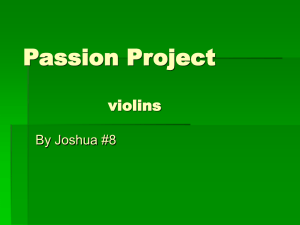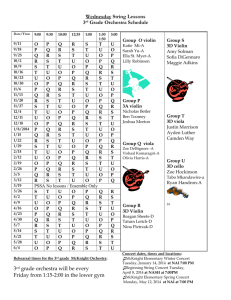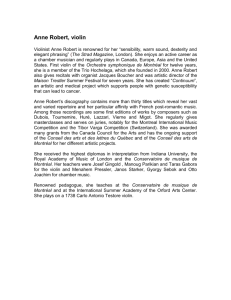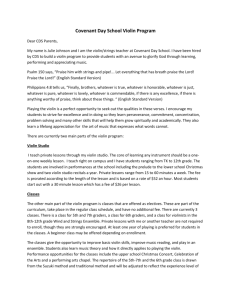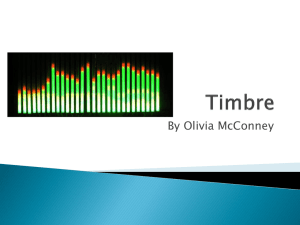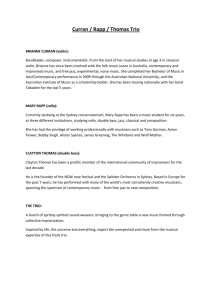2012 MASTA HIGH SCHOOL STRING CHAMBER MUSIC LIST
advertisement
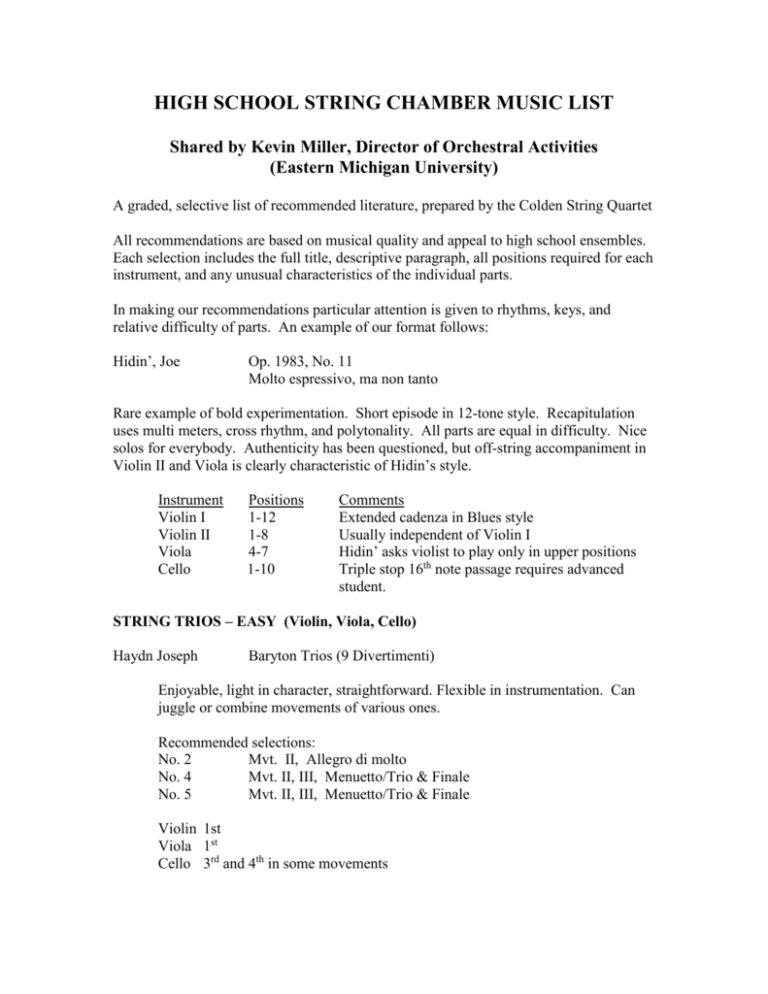
HIGH SCHOOL STRING CHAMBER MUSIC LIST Shared by Kevin Miller, Director of Orchestral Activities (Eastern Michigan University) A graded, selective list of recommended literature, prepared by the Colden String Quartet All recommendations are based on musical quality and appeal to high school ensembles. Each selection includes the full title, descriptive paragraph, all positions required for each instrument, and any unusual characteristics of the individual parts. In making our recommendations particular attention is given to rhythms, keys, and relative difficulty of parts. An example of our format follows: Hidin’, Joe Op. 1983, No. 11 Molto espressivo, ma non tanto Rare example of bold experimentation. Short episode in 12-tone style. Recapitulation uses multi meters, cross rhythm, and polytonality. All parts are equal in difficulty. Nice solos for everybody. Authenticity has been questioned, but off-string accompaniment in Violin II and Viola is clearly characteristic of Hidin’s style. Instrument Violin I Violin II Viola Cello Positions 1-12 1-8 4-7 1-10 Comments Extended cadenza in Blues style Usually independent of Violin I Hidin’ asks violist to play only in upper positions Triple stop 16th note passage requires advanced student. STRING TRIOS – EASY (Violin, Viola, Cello) Haydn Joseph Baryton Trios (9 Divertimenti) Enjoyable, light in character, straightforward. Flexible in instrumentation. Can juggle or combine movements of various ones. Recommended selections: No. 2 Mvt. II, Allegro di molto No. 4 Mvt. II, III, Menuetto/Trio & Finale No. 5 Mvt. II, III, Menuetto/Trio & Finale Violin 1st Viola 1st Cello 3rd and 4th in some movements STRING TRIOS—INTERMEDIATE Haydn Joseph Baryton Trios (9 Divertimenti) Enjoyable, light in character, straightforward. Equal interest and activity among parts. Flexibility in instrumentation provides greater utilization. Recommended selections: No. 6 Mvt. I, Allegro di molto No. 7 Complete Violin 1st Viola 1st Cello 1st Mozart 3 Divertimentos for String Trio in Bb, K. 4396 No. 1 – 3rd, 4th and 5th movts. No. 2 – 1st mvt. No. 3 - 5th mvt. Easy Classical style. Consistent, simple rhythm. Spiccato is needed. Mature players needed. Occasional unusual accidentals. Strong pulse in 4th and 5th mvts. Interesting viola and cello parts. Movements from these three divertimentos are interchangeable for programming. Violin 3rd Viola 3rd Cello 4th STRING TRIOS –ADVANCED Dohnanyi Serenade for String Trio , Op. 10 1st mvt. String march pulse. Harmonies can be difficult to hear. Some hard triple stops. Very expressive. Even parts. Many ensemble problems which are excellent for study. Violin 3rd Viola 3rd Cello 4th STRING QUARTETS – EASY (2 Violin, Viola, Cello) Clark, Irma (ed.) Introduction to String Quartets, Book II Easier than Book I. Styles range from Baroque to easy romantic. Mostly first position. Occasional chromatic alterations. Keys range in 1 or 2 sharps or flats. Rhythms are generally consistent and easy to comprehend. Optional Violin II can replace Viola. Recommended selections: No. 1 Entr’act from Rosamunde Bb M, Familiar, slow and tuneful No. 3 Allegretto by Mozart, A M, Fast and light, a little harder No. 5 The Trout by Schubert, DM Slow and lovely; rhythm is tricky No. 13 Rondeau by Purcell, Bb M, Even parts Clark, Irma (ed.) Introduction to String Quartets, Book I A collection with a good range of styles. Mostly in first position with occasional chromatic alterations. Optional Violin III can replace Viola. Wide range of keys and rhythms. Recommended selections: No. 1 Contredance by Beethoven, G M, Viola must count well No. 2 Contredance by Rameau, GM May need to eliminate turns No. 8 Austrian Hymn, by Haydn GM Theme only No. 10 St. Antoni Chorale by Haydn, Bb M, Familiar from Brahms’ Variations No. 15 Bourree by Handel, FM, Mostly quarter-note rhythm Clark, Irma (ed) String Music of the Baroque Era Good range of speeds, movement types, and difficulty. Very enjoyable to play. Viola part is much easier than the others. The rhythm in the Gigues is tricky. Mostly in easy keys. Violin II and Viola use only first position. Violin I and Cello must shift. Recommended selections: No. 3 La Rejouissance by handel, DM Some hard tied rhythm No. 4 La Badinerie by Bach, Bm medium level: harder for cello No. 8 Passacaile by Handel, GM Some flats; very enjoyable Cole, Hugo Miniature String Quartets (No. 1 & 2) Easy classical style. Good dynamic range and use. Equal parts and well edited. Some modal harmony. No. 1 No. 2 Haydn, Joseph 1st position. 1st position Quartet in CM, Op. 3, No. 2 (Vol IV, #65) Straightforward Minuet leads to a sprightly, energetic presto. Very few accidentals. Some trills which may need to be omitted. Very enjoyable. Basic spiccato strokes needed. Even parts. Position work is basic level. 1st Violin 2nd Violin Viola Cello Herfurth (ed,) 3rd 1st 3rd 4th One long syncopation passage Almost as hard as 1st violin part Some syncopation Early Classics A collection of well edited movement sin Classical style. Occasional chromatic alterations. Optional Violin III can replace viola, and Bass can replace cello. First position only. Narrow range of keys. Recommended selections: No. 2 St. Anthony’s Chorale - CM No. 4 Rigaudon by Purcell - DM Very easy for viola and cello No. 7 Allegro from Water Music - CM Mostly in rhythmic unison No. 18 Andante fom the “London” Symphonies - GM Needs some spiccato and chromatics. Purcell, Henry Chacony Common string orchestra piece. Also composed for string quartet. All parts are equally active in a contrapuntal Baroque style. A string Bass may be added to the quartet. In G minor. Chaconne is based on a beautiful harmonic sequence. Technically easy, but requires good rhythmic skills. Ultimate success of performance depends upon dynamic variation. 1st Violin 2nd Violin Viola Cello 3rd 1st 1st 1st STRING QUARTET - INTERMEDIATE Bach, J.S. 14 Fugues, Vol 1 Seven typical Bach fugues in quartet arrangement. Even parts. Counting must be absolutely secure. Wide range of keys. Balance must be very carefully worked out. Parts are overly edited; should simplify dynamics. Recommended selections: No. 2, 3, and 7. Violin I 1st, 3rd Violin II I Viola I Cello 1st -4th Boccherini Op. 8. No. 5 in D Presto Light, spirited movement. Simple texture. Some basic syncopation. Tends toward sharp keys with a brief moment in c# minor and g# minor. Only rhythmic complexity is in Violin I. Violin I Violin II Viola Cello Boccherini 1-4 1-3 1 1,2,4 Usually contains melody Imitates first violin with contrapuntal entrances Few double stops, short quick passage in DM A few tricky double sharps Opus 10, No. 2 in d Grave – Allegro Straightforward rhythm. Interesting introduction. Stays close to d minor harmonically. Written in cut time, yet sound good in a quick four. Some octave doubling of melody in the violins. Violin I Violin II Viola Cello 1-3 1 1 1, 4 Simple octaves Beethoven, Ludwig Opus 18, No. 4 Scherzo Good movement for first exposure to Beethoven. Requires basic off string technique. Has good solo moments for all four instruments. In C Major, with episodes in G, Eb. Violin I Violin II Viola Cello Boccherini, Luigi 1-6 1 1 1,4 May need to control tempo to prevent rushing Opens movement with fugue Opus 33, No. 6 in A Allegro, Andantino lentarella Minuetto con moto, Presto assai The whole piece is very satisfying. A few relatively complex rhythms in second movement, which is very expressive. Other three movement have no rhythmic problems. Violin 1 bears most of the melodic responsibility. Tends toward sharp keys. Violin I Violin II Viola Cello 1-3 1 1 1,4 Glazunov, Alexander Some extended runs in first position A few simple double stops, solo in Minuet Simple double stops; solo in second movement Interesting part; tenor clef; some melody 5 Novelettes III Interludium Very lush and expressive Andante movement. All parts haves solos. May wish to ignore markings to play sul A sul D, etc. modal harmonies entered on D dorian so there are few sharps or flats. Good for development of blended sound. Violin I Violin II Viola Cello 1-5 1-3 1-4 1-4 Uses treble clef A few bars written in treble clef. Tchaikovsky, P. String Quartet, Op. 11 Andante Cantabile Very warm, tender, romantic movement. Be sure tempo keeps moving. In Bb with one theme area in Db. Not technically difficult but needs students with a concept of blended sound and long phrasing. Violin I Violin II Viola Cello 1-5 1-3 1-3 1-6 Haydn, Joseph Carries bulk of melodic responsibility Shares return of principal theme with the viola Shares return of principal theme with Violin II One high Bb; mostly lower position; harmonic support Quartet Opus 74, No. 2 I Allegro spirituoso IV Finale, presto Light spirited movements; very enjoyable and rewarding to play. Overall , most demanding on Violin I although lower voices have equal interest and activity. Mvt. IV demands some independence among players. Good exercise in counting. Violin I Violin II Viola Cello 1-5 1-3 1st 1-4 Haydn, Josoph Opus 76, No. 3 Poco adagio cantabile The famous “Emperor” variations. Has universal appeal. Each instrument plays the full melody once. Very good for developing a full, rich quartet sound. Last variation is a very powerful climax. Sure to draw expression from any student group. In G major. Violin I 1-3 Violin II Viola Cello 1-3 1-3 1-6 Hindemith, Paul First variation requires good string crossing technique; very exposed continuous 16ths. Very exposed pizzicato at opening A few doubled stops More difficult than Violin II and Viola Eight Pieces, Op. 44 All parts playable in 1st position. Typical Hindemith tonality with many accidentals. Excellent introduction to dissonance. Very satisfying to play. Mostly within half-note to 8th note value range. Violin I is a little harder, and cello is a little easier than other pars. Movements can be played in many combinations. We like 1-4-7-5. Optional Bas part (does not replace cello). Mozart, W. A, Divertimento No. 1 Allegro, Andante, Presto All three movements are very appealing. Good piece for training students in the style of the Classical Period. Second movement is a beautiful due for the violins. Rhythm is generally straightforward. Ornaments and a few rhythmic patterns in the second movement may be a little tricky for Violin I. Violin I 1-4 Violin II Viola 1-3 1st Cello 1st Mozart, W. A. Should have basic skill in first 4 positions. Some triple stop chords. Close in difficulty to Violin I. Some triple stop chords. Mostly supportive but has very brief moments of importance Easiest part of the four. Divertimento No. 3 Presto All four parts are interesting. Movement is light in spirit with a sense of humor. In F, with a few unusual accidentals. Basic off sting technique necessary for good performance. Violin I 1-3 Violin II Viola Cello 1st 1st 1st Mozart, W. A. Melodic material has much charm. Bowing may be slightly uncomfortable Very independent of Violin I Also very independent Moving bass line Quartet in C Major, K. 157 Allegro Moderato, Andante, Presto Well-balanced set of movements from an excellent quartet of small proportions, in a light, lively mood. Keys stay in close relationship to C major. Parts are fairly equal with Violin I slightly more difficult, and cello usually outlining a simple bass line. Tricky syncopations in presto. Enjoyable quartet. Violin I 1-3 16th-note passages not difficult; some ornamentation Violin II Viola Cello 1st 1st 1-4 Mozart, W. A. Interesting part shares many passages with Violin I Interesting, active part Must have steady beat in Presto to control syncopation in other parts Quartet in F Major, K 168 Allegro (I), Allegro (IV) First and fourth movements make a pleasing set. First movement not difficult: lies low for Violin I. good opportunity to work on voice leading and fp techniques. Fourth movement is a fugue—not technically hard but tricky to count. High school students always enjoy this fugue. Violin I 1-3 Violin II 1st Viola 1st Cello 1-4 Not difficult Often in rhythmic unison with Violin I Not difficult yet maintains independence Mostly harmonic support in 1st movement Mozart, W. A. Quartet in Eb Major, K. 160 Mvt. 3, Presto Spirited march-like movement, a favorite with young groups. Requires ability to play off-string strokes. Upper voices have the more difficult parts. Good for developing ability to use dynamic contrasts and strong rhythmic pulse. Multiple stops in violins are usually doubling and can easily be simplified. Violin I Violin II Viola Cello 1-3 1st 1st 1st Mozart, W. A. Quartet in G Major, K. 387 Minuetto Lyrical minuet. Rhythmic independence needed. Many chromatic passages. Requires sensitivity to be musically successful. Some trills which can be difficult. Key ranges from D Major to Eb major. Harder intermediate level. Violin I Violin II Viola Cello 1-3-4 1st 1st 1-4 Difficult to play chromatic passages clearly Schubert, F. Quartet in D Major, No. 7 Menuetto Boisterous minuet with a delicate trio section. Tempo must be brisk with strong feeling in one. Violin I always has melody, is the only part at intermediate level (others Easy). Some chromatics and martele needed. Minuet in DM, trio in Bb. Violin I Violin II Viola Cello 1-5 1st 1st 1st Stone, David Fifth position at most climactic moments Miniature Quartet No. 1 Modal tonality. Unusual and involved rhythms. Very expressive. Easier for intermediate level. Even parts. All parts in 1st position except for brief moments in 3rd mvt. For Violin I. Very few sharps or flats. Needs good bow control. Stone, David Miniature Quartet No. 2 Difficult rhythms. Modal harmony. Wide range of expression. Even parts. Some tricky tempo changes. Needs time to learn, but well worth it. All in 1st position. Wide range of accidentals. Needs good rhythmic control. ADVANCED – QUARTETS Arriaga, J.C. de 1st Quartet, d minor Allegro, Adagio, Menuetto, Allegretto Spirited, enjoyable quartet in Classical style. Wide range of keys; can be quiet chromatic. Some brilliant passages for Violin I especially in last movement. Other parts significantly easier although Violin II shares some solos. Definitely needs a fine first violinist. Violin I 1-7 More difficult advanced level Violin II 1-5 Viola 1-5 Cello 1-thumb Active; some melody in 1st and 2nd movts. Barber, Samuel String Quartet, Op. 11 Molto allegro e appassionato First movement only! Very dramatic. All parts very active and even in difficulty. Requires a good sense of rhythm. In D Major but continually shifts from one harmonic area to another, with many colorful accidentals. Very good example of strong inventive writing using common 20th Century techniques. Violin I 1-7 Violin II 1-5 Viola 1-6 Cello 1-7 Beethoven, L. Must be confident leader for ritards, accelerandos, fermatas Mostly supportive but needs to match 1st Vl in intensity A few very important solos; high moments are brief Few high notes; some very hard syncopation Opus 18, No. 2 Allegro molto quasi presto Excellent for first experience with Beethoven. Rhythmically straightforward; harmonically imaginative. Movement is in GM moving to gm and DM; touches Ab and E briefly. Notice the Viola and Violin II parts are much easier. May want to take at somewhat modest tempo. Violin I is definitely harder than others. Violin I Violin II Viola Cello 1-6 1st 1st 1-4 Beethoven, L. Needs a good advanced students Not hard but satisfying Not hard but satisfying Nice solos at opening Opus 18, No. 4 Allegro ma non tanto, Scherzo Menuetto, Allegro Entire piece is very rewarding for high school students, Scherzo very good by itself for an intermediate group, and evenly balanced. In C minor; harmonically inventive, with a few Gb’s. Among Op. 18 quartets, the most dramatic. Violin I 1-10 Violin II 1-3 Viola Cello 1-3 1-7 Triple stop chords, some extended 16th notes runs Needs very good student; harder than viol; many nice solos Second theme solo in 1st movt. Is demanding and beautiful Boccherini, Luigi Opus 39, No. 1 in C Finale. Allegro giusto Full, rich texture with lots of chords for everyone. Must be careful with tempo; not too fast at opening Very stylistic, with decorative ornamentation in Violin I. More depth than most Boccherini. In C Major but begins briefly in cm. Dramatic! Violin I Violin II Viola Cello 1-3 1st 1st 1-4 Borodin, Alexander Soloistic. Requires quick left hand Simple triple stop chords Simple double stops Some tenor clef; interesting part Quartet No. 2 Mvt. I—Allegro moderato Characteristic of late Romantic period. Lyric; rich harmonic texture. Includes melodic solos, especially for Violin I and Cello. All parts include short, fast chromatic passages. Popular, enjoyable among all groups. Violin I Violin II Viola Cello 1-9 1-3 1-3 1-thumb Haydn, Joseph Should have an expressive student Mostly simple accompaniment with some double stops Mostly simple accompaniment with some double stops Challenging opening solo Quartet in d minor, Op. 76, No. 2 “Quinten” Allegro, Andante, Menuetto, Allegro, Finale-Vivace assai Quartet of dramatic intensity. Four movements of contrasting styles, each can stand on its own. Technically and musically demanding. Ranks among most difficult of Haydn’s quartets. Menuettos written in a canon between the two higher and lower instruments. Although hard, is excellent and worth the effort. Violin I Violin II Viola Cello Full range 1-3 1-3 1-4 Very difficult Almost exclusively supportive Active, interesting part Mostly supportive, occasionally leading voice Joplin, Scott, arr. Wm. Zinn Ragtime Favorites Good collection of rags in straightforward arrangements. 1st Violin usually carries the melody; is much harder than other parts. Typical ragtime syncopation can be difficult. Enjoyable, and should be considered as quality music, as well as fun. Rags get progressively harder and first on “Country Club” is advanced level only because of rhythmic needs. Optional Bass part (doesn’t replace cello). Keys range from Eb major to A Major. Violin I 1-3 Violin II 1st Viola 1-3 Cello 1-4 Schubert, F. Earliest rags mostly in 1st position; later rags have difficult double stops Often in rhythmic unison in Violin I Early rags have a few hard stops; become common later Many skips and some hard double stops Quartet in A minor, Op. 29 Andante Very expressive, harmonically rich movement. Tempo must keep moving uses many keys and accidentals. Challenging to play in tune. Requires excellent control of sound. Even parts. Everyone has difficult, fast arpeggiated figures towards end of movement. Split bowings over whole measures into two bows. Violin I 1-5 Violin II 1-3 Viola Cello 1-4 1-4 Schubert, F. Very lyric part Has moving inside accompaniment figure; may simplify double stops Involved part; a few soloistic moments Requires good knowledge of positions. Quartet in D Major, No. 7 Andante con moto Expressive movement with many dynamic markings. Violin I always has the melody and is the only part at advanced level. Tempo must keep moving in pulse of two. Some chromatic lines. Requires sensitivity and attempts to detail. A great deal to be learned about chamber music in this piece. Many accidentals within a G major key. Violin I Violin II Viola Cello 1-6 1st 1st 1st Should have experience with leading Some simple double stops. Intermed. level Intermediate level Easiest of four parts; intermediate level Schubert, F. Quartet in Eb, Opus 125, No. 1 Allegro Moderato, Adagio Two pleasant and uncomplicated movements. Violin I is hardest; usually having the melody. Rich harmonic language without beig hard. Being in Eb has many flats (some G and D flats) used. Must have sensitive taste, good bow control, and a blend of sound. Violin I Violin II Viola Cello 1-5 1st 1st 1-4 Many short phrases which require good leading No upper positions but often must match Violin I Intermediate level Easiest of parts; intermediate level CHAMBER MUSIC WITH BASS – EASY Mozart, W.A. 7 Minuets with Trios for 2 Violins, & Double Bass, K. 65a Light, charming, short pieces. Independence between violin parts, yet within easy grasp. Uses various techniques good for training: triplets, trills, double stops (can be simplified, if necessary). Bass part can be played by cellist. Violin I 1-3 Violin II 1st Bass 1-4 CHAMBER MUSIC WITH BASS – INTERMEDIATE Beethoven, L 6 minuets for 2 Violins and Double Bass Light , enjoyable dances. In places the bass part may need to be played an octave higher than written. Violin I 1-3 Violin II 1st Bass 31/2 Some double stops; may be simplified, if necessary CHAMBER MUSIC WITH BASS – ADVANCED Dvorak Quintet in G major, Op. 77 Scherzo Lively scherzo with a charming melodic trio. Most accessible movement in the piece. Scherzo is in E minor; trio in C major but some EM and AM. Full texture with bass makes movement seem orchestral. Has lots of drive with some soaring melodies. Violin I 1-6 Violin II Viola Cello Bass 1-3 1-3 1-4 1-3 Beautiful solo in trio. Changes from 16th to triplets are tricky. Octave doubling with Violin I. Needs good pitch Some hard double stops. Solo in Trio no “Dvorak” treble clef Not as difficult as other pars, but challenging for ensemble skills.
